Heliotrope: Grow & Care for Heliotropium
Written by Iris
Jul 30 2021
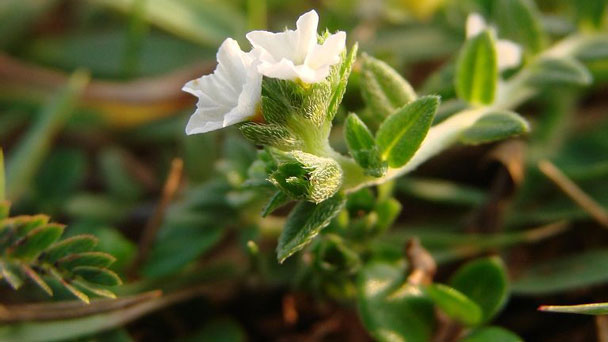
Heliotrope (Heliotropium) is a very easy to grow herbaceous flowering plant. The flowers of Heliotrope (Heliotropium) are dark purple with a charming cherry fragrance. Its purple flowers are very easy to attract bees and butterflies. It is very suitable for growing potted plants or Hanging basin. In addition to purple flowers, heliotrope also has blue, white and other varieties. It is very suitable for planting in flower pots. The flowers will grow into clusters, which are very beautiful and very ornamental.
Sow 1/8-inch deep in seed starting trays with good quality potting soil and cover them lightly with soil.
Germination can take between 28-40 days, during which time the soil needs to be kept at an even temperature of 70-75°F. You may need to use a heat mat. Maintain even moisture but do not allow the soil to become over-saturated.
After germination, keep the seedlings indoors until the danger of frost has passed and the soil your garden has warmed to 60°F.
As the seedlings mature, pinch back the growing tips to promote lateral, bushy growth.
Seeds do not produce the most reliable results, nor the strongest plants. Hybrids do not produce seed that replicates the traits and quality of a parent plant.
This is an excellent way to clone a favorite plant and give it a chance to grow strong before planting out the following spring.
Cut a five-inch section of a stem, just below a leaf node. Remove the leaves from the top half of the stem cutting, dip in powered rooting hormone and place in a small pot filled with a mixture of sand and perlite, or potting medium.
Keep the rooting cuttings indoors, or in a greenhouse, and maintain even moisture. They should develop roots within two weeks.
Once rooted, keep the soil moist but not waterlogged and they’ll be ready to plant out after the last spring frost date passes.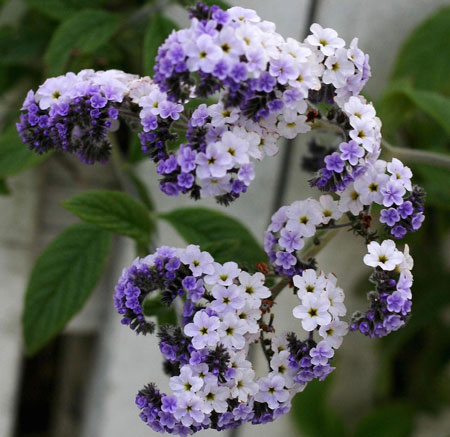
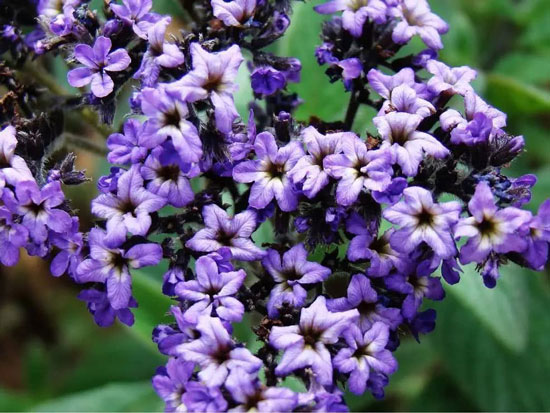
Pests to watch out for include:
Usually all it takes to get rid of these pests is a spray from the hose. If that's not enough, treat affected plants with neem oil or an insecticidal soap.
While not prone to disease, sometimes the leaves may turn brown and begin to drop off. It may appear that the plant is thirsty, when in fact, the soil is actually too wet.
Check the soil for excess moisture before assuming plants are too dry, or you may make the problem worse. Plants that are too wet are susceptible to fungal infection and rotting.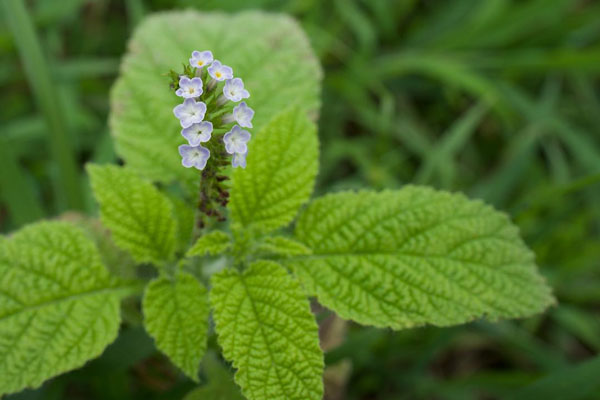
The most fragrant varieties of heliotrope are, ‘Alba’, ‘Fragrant Delight’, ‘Iowa,’ and, ‘Sachet.’ The ‘mini-marine’ variety grows only 8 to 10 inches tall, perfect for window boxes and small pots. The ‘chatsworth’ variety won the Royal Horticultural Society’s Award of Garden Merit, and display’s bright purple blooms and an extended blooming period.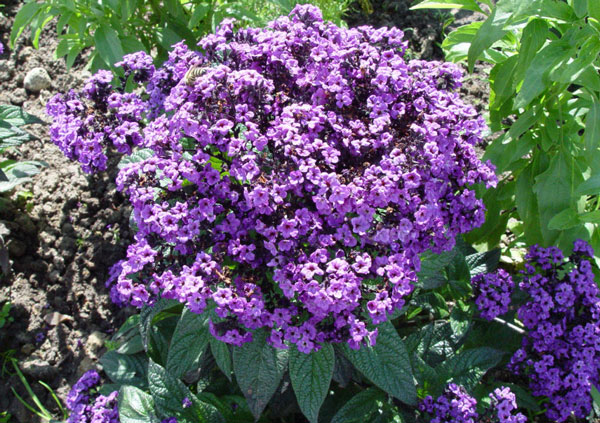
Your chosen pot should have drainage holes in the bottom. These flowers dislike sitting in overly wet or soggy soil.
Fill your pot or pots with a rich, well-draining potting mix. A fresh general purpose potting mix with some organic matter, such as compost, worked in is ideal. Alternatively, you can mix a handful or two of sand into your general purpose potting mix. This helps to improve drainage.
How to Grow Heliotrope (Heliotropium)How to Care for Heliotrope (Heliotropium)Varieties of Heliotrope (Heliotropium)Heliotrope (Heliotropium) FAQ
How to Grow Heliotrope (Heliotropium)
Steps for Heliotrope (Heliotropium) Propagation with Seeds
Start seeds indoors 10 to 12 weeks before the last average frost date for your region.Sow 1/8-inch deep in seed starting trays with good quality potting soil and cover them lightly with soil.
Germination can take between 28-40 days, during which time the soil needs to be kept at an even temperature of 70-75°F. You may need to use a heat mat. Maintain even moisture but do not allow the soil to become over-saturated.
After germination, keep the seedlings indoors until the danger of frost has passed and the soil your garden has warmed to 60°F.
As the seedlings mature, pinch back the growing tips to promote lateral, bushy growth.
Seeds do not produce the most reliable results, nor the strongest plants. Hybrids do not produce seed that replicates the traits and quality of a parent plant.
Steps for Heliotrope (Heliotropium) Propagation with Stem Cuttings
Towards summer's end, you may cut stem tips from existing plants to root for next year.This is an excellent way to clone a favorite plant and give it a chance to grow strong before planting out the following spring.
Cut a five-inch section of a stem, just below a leaf node. Remove the leaves from the top half of the stem cutting, dip in powered rooting hormone and place in a small pot filled with a mixture of sand and perlite, or potting medium.
Keep the rooting cuttings indoors, or in a greenhouse, and maintain even moisture. They should develop roots within two weeks.
Once rooted, keep the soil moist but not waterlogged and they’ll be ready to plant out after the last spring frost date passes.

How to Care for Heliotrope (Heliotropium)
Light
Heliotropes are full sun plants that require at least six hours a day of direct sunlight. However, they prefer morning sun and in hot climates, intense afternoon rays may burn the delicate flowers. A location that receives bright morning sunlight and light shade in the afternoon is ideal.Soil
Plant heliotropes in rich, loamy soil that is well-draining but retains some water. They prefer soil that is rich in organic matter, with a pH between 6.6 and 7.3. Heliotropes do not do well in heavy clay soils as they cannot tolerate ‘wet feet.’Water
Keep the soil evenly moist. Don’t let it dry out. While the soil should never be allowed to dry out, it also shouldn’t be allowed to become overly wet or soggy. This balance can be difficult to achieve, particularly in pots. A soil moisture meter, such as the Gouevn Moisture Meter, allows you to accurately monitor the moisture content of your soil. This makes knowing when to water your plants a lot easier.Temperature and Humidity
Heliotropes grow best in dry climates with warm days and cool nights. They do not do well in overly hot or humid weather and they are highly frost-tender. They grow well in USDA zones 9 through 11.Fertilizer
Fertilize your plants regularly. Heliotrope is a heavy feeding plant. If planted in the ground they require an application of a well balanced or phosphorus rich liquid fertilizer once every two weeks. Phosphorus rich fertilizers encourage more flowers to form. Avoid feeding your plants nitrogen heavy fertilizers. These encourage leaf production at the expense of flowering.Pruning
Regularly pruning your heliotrope plant will encourage consistent blooms and a fuller growth habit. You can begin pinching back the stems and flowers in the early spring to encourage more lateral growth. This may delay the initial bloom but you will be rewarded with larger and more prolific blooms throughout the rest of the season.
Pests and Diseases
Healthy heliotropes are unlikely to suffer from pests or disease. However, under less than ideal conditions, issues may arise.Pests to watch out for include:
- Aphids
- Mealybugs
- Spider mites
- Whiteflies
Usually all it takes to get rid of these pests is a spray from the hose. If that's not enough, treat affected plants with neem oil or an insecticidal soap.
While not prone to disease, sometimes the leaves may turn brown and begin to drop off. It may appear that the plant is thirsty, when in fact, the soil is actually too wet.
Check the soil for excess moisture before assuming plants are too dry, or you may make the problem worse. Plants that are too wet are susceptible to fungal infection and rotting.

Varieties of Heliotrope (Heliotropium)
As with most popular flowers, heliotrope has been altered and bred until there are lots of different cultivars to choose from. The most popular varieties of heliotrope are the colorful and hardy ‘Princess Marina,’ ‘Mary Fox,’ the taller varietal, ‘Florence Nightingale,’ and the highly inviting and fragrant varieties, “White Lady” and “White Queen.” Some heliotrope hybrids were bred for their looks only and are somewhat lacking in the fragrance department.The most fragrant varieties of heliotrope are, ‘Alba’, ‘Fragrant Delight’, ‘Iowa,’ and, ‘Sachet.’ The ‘mini-marine’ variety grows only 8 to 10 inches tall, perfect for window boxes and small pots. The ‘chatsworth’ variety won the Royal Horticultural Society’s Award of Garden Merit, and display’s bright purple blooms and an extended blooming period.

Heliotrope (Heliotropium) FAQ
Are Heliotropes Toxic?
All parts of heliotrope plants are highly toxic to dogs, cats, and livestock when ingested, leading to liver failure and even death. If consumed in large quantities, they can also be toxic to humans. If you are worried about curious pets or children getting into these plants, planting them in hanging baskets or containers that are out of reach is recommended.Can I Grow Heliotrope in a Container?
These attractive flowers are ideal for container gardens. They are pleasingly robust and are not susceptible to pests or diseases such as powdery mildew. They are also not invasive and are unlikely to overpower and smother other flowers planted in the same container.Your chosen pot should have drainage holes in the bottom. These flowers dislike sitting in overly wet or soggy soil.
Fill your pot or pots with a rich, well-draining potting mix. A fresh general purpose potting mix with some organic matter, such as compost, worked in is ideal. Alternatively, you can mix a handful or two of sand into your general purpose potting mix. This helps to improve drainage.
Latest Updated
- Benefits of Bugleweed - 7 Science-backed Health Benefits
- Bugleweed Dangers & Side Effects - Is It Poisonous?
- How to Plant Evergreen Trees - What You Should Know
- When to Plant Evergreens - Grow Guide for Evergreen Trees
- 12 Wonderful Evergreen Shrubs for Your Garden
- 12 Popular Evergreen Plants with Pictures for Beginners
- When And How To Prune A Lilac Bush Like a Pro
- How to Grow & Care for Lilac Vine (Hardenbergia Violacea)
- Japanese Lilac Tree (Syringa Reticulata) Care & Propagation Guide
- Shumard Oak Pros and Cons - What to Know
Popular Articles
- Winter maintenance of Antirrhinum Majus
- How to Grow Terminalia Mantaly Tree
- How to Grow and Care for Crossostephium Chinense
- How to grow Antirrhinum Majus in spring
- Peristeria Elata (Dove Orchid) Profile: Info & Care Guide
- Underwatered Snake Plant (Sansevieria Trifasciata) - Signs And How To Fix
- How to Care for Brazilian Jasmine Plant (Mandevilla Sanderi)
- How to Grow & Care for Graptopetalum Purple Delight in Summer
- Rosa Chinensis (China Rose): Plant Growing & Care Tips
- How to Care for Baby Sun Rose (Aptenia Cordifolia)